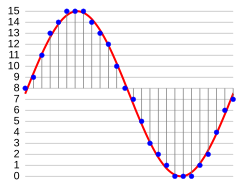It is proposed that this article be deleted because of the following concern:
If you can address this concern by improving, copyediting, sourcing, renaming, or merging the page, please edit this page and do so. You may remove this message if you improve the article or otherwise object to deletion for any reason. Although not required, you are encouraged to explain why you object to the deletion, either in your edit summary or on the talk page. If this template is removed, do not replace it. The article may be deleted if this message remains in place for seven days, i.e., after 09:37, 5 September 2025 (UTC). Find sources: "Content format" – news · newspapers · books · scholar · JSTOR |
A content format is an encoded format for converting a specific type of data to displayable information. Content formats are used in recording and transmission to prepare data for observation or interpretation.[1][2] This includes both analog and digitized content. Content formats may be recorded and read by either natural or manufactured tools and mechanisms.

In addition to converting data to information, a content format may include the encryption and/or scrambling of that information.[3] Multiple content formats may be contained within a single section of a storage medium (e.g. track, disk sector, computer file, document, page, column) or transmitted via a single channel (e.g. wire, carrier wave) of a transmission medium. With multimedia, multiple tracks containing multiple content formats are presented simultaneously. Content formats may either be recorded in secondary signal processing methods such as a software container format (e.g. digital audio, digital video) or recorded in the primary format (e.g. spectrogram, pictogram).
Observable data is often known as raw data, or raw content.[4] A primary raw content format may be directly observable (e.g. image, sound, motion, smell, sensation) or physical data which only requires hardware to display it, such as a phonographic needle and diaphragm or a projector lamp and magnifying glass.
There has been a countless number of content formats throughout history. The following are examples of some common content formats and content format categories (covering: sensory experience, model, and language used for encoding information):
See also
editReferences
edit- ^ Bob Boiko, Content Management Bible, Nov 2004 pp:79, 240, 830
- ^ Ann Rockley, Managing Enterprise Content: A Unified Content Strategy, Oct 2002 pp:269, 320, 516
- ^ Jessica Keyes, Technology Trendlines, Jul 1995 pp:201
- ^ Oge Marques and Borko Furht, Content-Based Image and Video Retrieval, April 2002 pp:15
- ^ David Austerberry, The Technology of Video and Audio Streaming, Second Edition, Sep 2004 pp: 328
- ^ M. Ghanbari, Standard Codecs: Image Compression to Advanced Video Coding, Jun 2003 pp:364